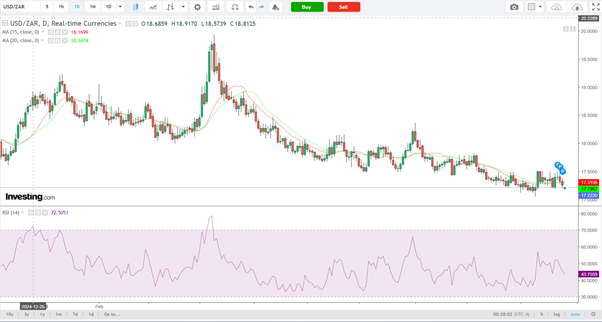Eos Energy stock falls after Fuzzy Panda issues short report
AUD/CHF is currently trading near 0.5158, recovering modestly after bouncing off recent lows around 0.5070. Despite the rebound, the pair remains under pressure below both the 15-day and 20-day simple moving averages, indicating that the short-term trend continues to favour the bears.
The pair recently broke below the key horizontal support zone at 0.5180–0.5200, which has now turned into resistance. Price is currently retesting this zone, and a failure to close above it would likely confirm the continuation of the broader downtrend. Momentum indicators show limited upside strength, with sellers expected to re-emerge near current levels.
On the downside, initial support lies around 0.5120, followed by 0.5070, which marks the recent swing low and key demand area from earlier this year. A decisive daily close below 0.5070 would expose the next support at 0.5000, potentially extending the bearish leg lower.
Conversely, a sustained move above 0.5200–0.5220 would be needed to negate the current bearish bias and open the door for a recovery toward 0.5280–0.5320.
Overall, the pair remains bearish in the short term, with price action showing clear rejection from the moving averages and the former support zone at 0.5180. Unless the pair closes convincingly above 0.5220, the path of least resistance continues to point lower toward 0.5070 and 0.5000.
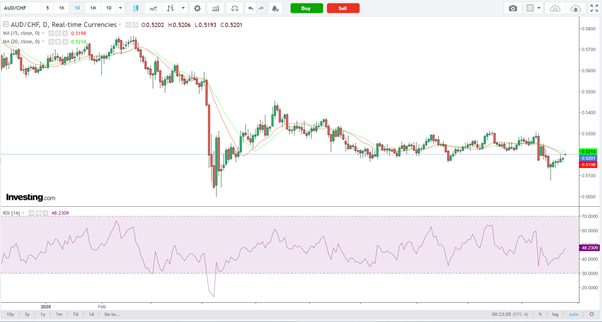
AUD/USD is currently trading near 0.6498, holding just below the 0.6510–0.6520 zone — a key horizontal resistance level that has defined much of the recent range. The pair has struggled to build momentum after several failed attempts to reclaim its short-term moving averages, with both the 15-day and 20-day simple moving averages flattening and capping price near 0.6512–0.6513.
Price action suggests that sellers continue to defend this area aggressively, keeping AUDUSD trapped in a consolidation phase after the sharp October pullback from the 0.6650 region. A daily close below 0.6470 would likely confirm a continuation of the downtrend, opening the way toward 0.6400 and 0.6340, where previous demand emerged in late August.
On the upside, a sustained break above 0.6520–0.6550 would be needed to signal a shift in short-term momentum, targeting 0.6600 initially and then 0.6650, the October swing high. Until that occurs, the structure remains bearish, with rallies likely to attract selling interest.
Overall, the pair remains in a short-term bearish phase within a broader sideways structure. Momentum indicators continue to lean negative, and unless buyers can reclaim control above 0.6550, the pair risks another leg lower toward 0.6400 as sellers maintain dominance below the moving averages.
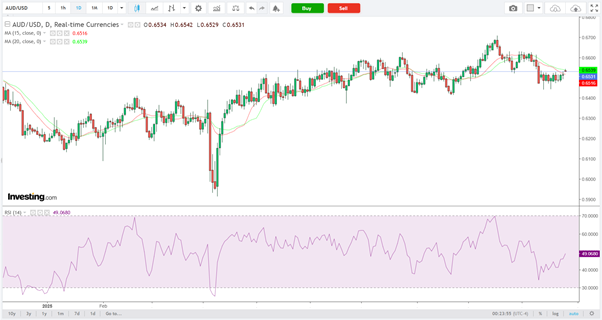
EUR/USD is currently trading near 1.1677, consolidating just above the 1.1620 horizontal support zone after several failed attempts to sustain momentum above 1.1700. The pair remains capped by both the 15-day and 20-day simple moving averages, which are converging around 1.1665–1.1670, indicating that the short-term bias continues to lean bearish.
Price action over the past few weeks reflects a gradual loss of bullish momentum following the late-September recovery, with sellers repeatedly stepping in near 1.1700–1.1720. A daily close below 1.1600 would confirm renewed downside pressure, potentially opening the way toward 1.1520 and 1.1450, where the next major support levels lie.
On the upside, resistance is now seen at 1.1700–1.1720, followed by 1.1780, which represents the October swing high. A decisive close above 1.1720 would be required to shift momentum in favour of buyers and signal the start of a potential corrective rally toward 1.1800–1.1850.
Overall, the pair remains bearish in the short term, with price action constrained below the key moving averages. Unless the pair can reclaim and hold above 1.1720, the technical outlook favours continued consolidation or a gradual drift lower toward 1.1520, as sellers maintain control near the current resistance band.
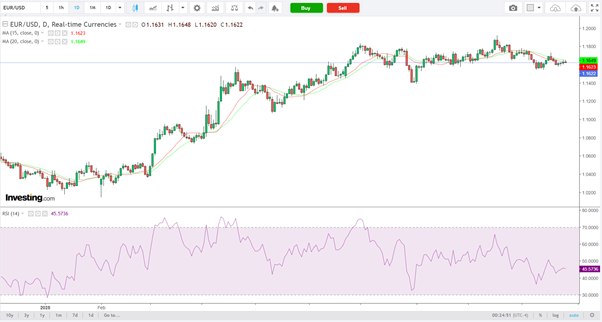
GBPUSD is currently trading near 1.3255, remaining under pressure as sellers continue to dominate below the 1.3400 handle. The pair has failed to recover above both the 15-day and 20-day simple moving averages, currently positioned around 1.3427–1.3457, indicating that short-term momentum remains bearish.
Price action shows a series of lower highs since mid-September, reflecting a gradual loss of bullish momentum. The 1.3310–1.3280 area now serves as immediate support — a critical zone that has acted as both a floor and pivot in recent months. A daily close below 1.3280 would confirm renewed downside pressure, potentially opening the path toward 1.3160 and 1.3050, where previous demand emerged.
On the upside, resistance lies at 1.3400–1.3450, coinciding with the declining moving averages. A sustained move above 1.3460 would be required to neutralize the current bearish bias and signal the possibility of a rebound toward 1.3550–1.3620.
Overall, the pair remains bearish in the near term, with sellers in control below the moving averages. A break below 1.3280 would reinforce the downward bias, while only a decisive recovery above 1.3460 would shift sentiment back in favour of buyers.

USD/CAD is currently trading around 1.3752, consolidating after pulling back from the 1.4000 psychological resistance zone. The broader trend remains bullish, as the pair continues to hold above both the 15-day and 20-day simple moving averages (now at 1.3740 and 1.3770, respectively). However, momentum has slowed, with price action showing indecision just beneath a well-defined resistance structure.
The pair has repeatedly tested the 1.4000–1.4040 zone over the past few weeks, highlighting it as a critical ceiling for bulls. A daily close above 1.4050 would confirm a bullish breakout, exposing upside targets near 1.4150 and potentially 1.4250, which align with prior swing highs.
On the downside, immediate support rests at 1.3720–1.3680, where the short-term moving averages converge with the prior breakout zone from early October. A sustained move below 1.3680 would weaken the bullish structure and suggest a deeper retracement toward 1.3600 and 1.3520.
Overall, the pair is in a holding pattern just below key resistance, with the bias remaining cautiously bullish as long as the pair holds above 1.3700. A decisive breakout above 1.4050 would resume the uptrend, while a failure to hold the moving averages could trigger a shift toward consolidation or a corrective phase.
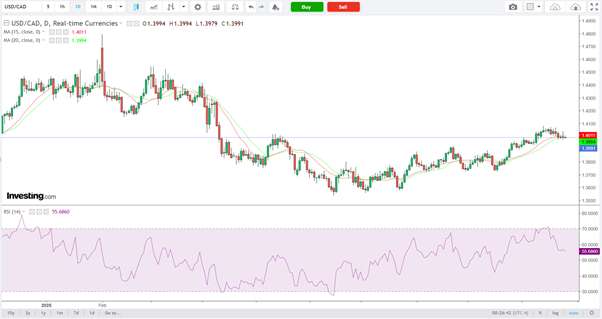
USD/CHF is currently trading near 0.8228, hovering just below both the 15-day and 20-day simple moving averages at 0.8252 and 0.8288, respectively. The pair has struggled to maintain upward momentum, indicating persistent selling pressure within a broader sideways-to-downward structure that has dominated since mid-year.
Price action suggests that the market remains capped below the 0.8300 resistance zone — a key level that has repeatedly rejected bullish attempts over recent weeks. A daily close above 0.8300–0.8320 would be needed to shift the near-term bias toward recovery, targeting 0.8400 and 0.8500 as potential upside levels.
On the downside, initial support lies at 0.8150–0.8120, followed by 0.8050, where previous consolidation formed in September and October. A sustained break below 0.8050 would likely confirm renewed bearish control, opening the path toward 0.7950 and possibly 0.7800 — levels not seen since early 2024.
Overall, the pair remains bearish to neutral, with momentum indicators showing limited conviction from buyers. The pair would need to reclaim 0.8300 decisively to confirm a reversal, while failure to hold above 0.8150 would keep the door open for deeper downside continuation.
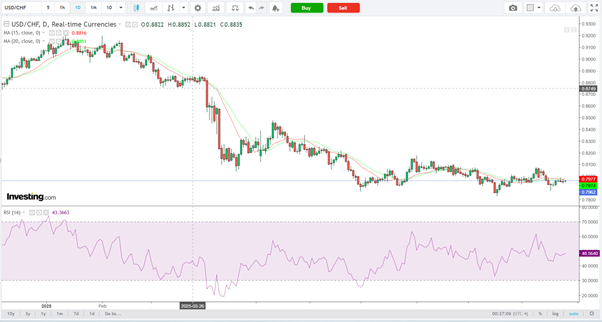
USD/JPY is currently trading near 147.11, consolidating after testing the 152.90 resistance area — a critical multi-month ceiling that has repeatedly capped upside momentum since mid-2022. Despite the latest pullback, the pair maintains a firmly bullish bias, supported by both the 15-day and 20-day simple moving averages (now at 147.88 and 147.69, respectively), which continue to slope upward.
Price action shows that buyers remain in control as long as the pair holds above 147.00, which aligns with both short-term moving averages and prior breakout levels from early October. A daily close above 152.90 would mark a decisive breakout, opening the path for an advance toward 154.50 and potentially 156.00, with trend momentum favouring the upside as long as the U.S. yield environment remains supportive.
Conversely, failure to clear 152.90 could invite another round of profit-taking, with initial support seen at 150.50–150.00, followed by 148.00 as a deeper retracement zone. A sustained close below 147.00 would suggest short-term exhaustion and shift the bias toward consolidation or mild correction.
Overall, the pair remains bullish, consolidating below key resistance with strong trend structure intact. The focus remains on whether bulls can secure a breakout above 152.90 — a move that would confirm continuation of the long-term uptrend.
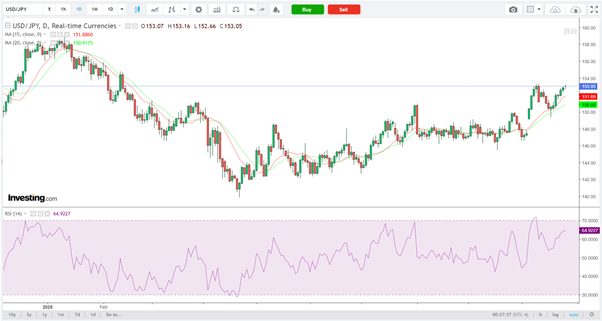
USD/ZAR is currently trading near 17.56, showing mild recovery momentum after rebounding from the 17.20 support area — a level that has repeatedly acted as a key pivot throughout October. Despite this short-term bounce, the broader structure remains bearish, with both the 15-day and 20-day simple moving averages (at 17.76 and 17.78, respectively) still trending downward, reflecting persistent downside pressure.
The pair has been confined within a tight consolidation range between 17.20 and 17.80, as market participants weigh dollar strength against improving sentiment toward emerging-market currencies. A daily close above 17.80 would be needed to shift the near-term bias toward bullish continuation, opening upside targets at 18.00 and 18.25.
Conversely, a sustained move below 17.20 would confirm a bearish breakdown, exposing deeper downside levels near 16.90 and 16.70, marking the next technical supports from mid-2023 lows.
Overall, the pair remains in a neutral-to-bearish consolidation phase, with momentum indicators still favouring sellers unless a decisive break above 17.80 occurs. Traders should monitor the 17.20–17.80 band for directional confirmation, as a breakout on either side is likely to define the next medium-term move.
